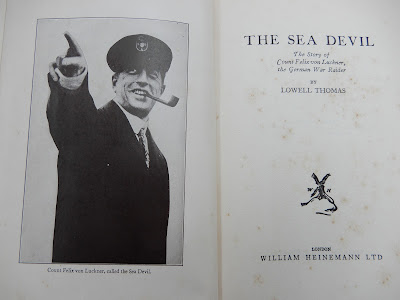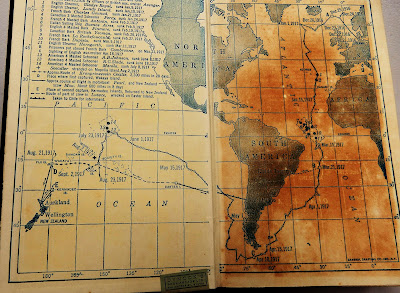German war raider posed as Queensland boxing champion, shone as a wrestler
The swashbuckling true life adventures of Count Felix von Luckner who wreaked havoc among Atlantic and South Pacific shipping during WWl was presented in great detail by American author Lowell Thomas in this blog's 1931 inscribed copy of The Sea Devil . Out of the book fell the faded business card of the owner all those years ago , Dr N. J. "Jock" Symington , who in the early l930s had charge of infectious diseases in Sydney, including leprosy .
At the age of thirteen and a half , Count Luckner ran away to sea, going under the name Phelax Luedige, , taken from his mother's side of the family . A voyage as a cabin boy aboard an old Russian full rigged ship brought him to Fremantle ,Western Australia , where he was attracted to the Salvation Army , because of their band , which reminded him of bands back home . Joining the Sallies, he sold copies of their newspaper , War Cry, and let it be known that he was Count von Lucker. The Salvationists paraded him about as an example of God saving him from demon grog and sin .
A job he obtained included polishing the lenses on the Cape Leeuwin Lighthouse . He tried his hand at commercial kangaroo shooting . Somehow, he became involved in Australia with a group of "Indian fakirs" who travelled about performing magic shows , performing many slight of hand tricks , some of which he picked up .
Because of his size and strength , he was trained as a boxer , with a plan to bill him as the Queensland Champion who would be taken to America and become a big attraction .
However, the call of the seven seas and demon grog lured him back to the mast .The first German ship he served on was Caesarea , on which he broke a leg , then another , which brought cargo from Hamburg to Melbourne . The German consul was entertained in Melbourne and Felix was made the ship's cook by the skipper who earlier had given him a flogging .
Then a shipload of Australian coal was loaded for Chile and von Luckner spent New Year in a Chilean dungeon after a spree ashore . For a short time , he joined the Mexican Army ; worked as a tavern keeper and bartender in Hamburg ; served for two years as mate on the Hamburg-American Line ; there was a bizarre episode ashore in Honolulu , at a strange plantation where a man making out he was a tailor ran a tape measure over parts of his body . Then after spotting what looked like a chopped off human thumb , he knocked the man down , ran and hid in the cane , while men on horses with whistles searched for him .
Because of his exploits, written up in newspapers , which included saving drowning people , he was ordered to report to the navy for active service in February 1912, the Emperor and Prince Henry no less had both become interested in him .
The Emperor had him transferred to the West African station , the Cameroons , aboard the Panther . The book deals with that time in great detail ,with interesting insights about colonial power rivalries , competing religious faiths in Africa .
SKIPPER OF A DARING RAIDER
In 1916, Count von Luckner was summoned to Berlin and ordered to run the British blockade of Germany and raid enemy commercial shipping . Because there were no German coaling stations, a sailing ship would have to be used, the former American clipper built in Glasgow, Pass of Galmaha.
It was hastily converted into an auxiliary cruiser with concealed guns ,rifles, grenades,bombs,special quarters for prisoners , a tank holding 480 tons of fuel oil, provisions for a two year cruise. Posing as a neutral Norwegian clipper bound for Melbourne with a cargo of timber, the vessel sallied forth , under the name Seeadler , sinking many ships over 224 days, covering about 30,000 miles . The extraordinary adventures are indicated in parts of the endpaper information and maps that follow .
Captured in New Zealand waters, the Count was imprisoned on an island, managed to make a fake British uniform , escaped, stole a boat and was later apprehended in the Kermadecs. Brought back to Auckland , his party was planning another escape when the war ended .







